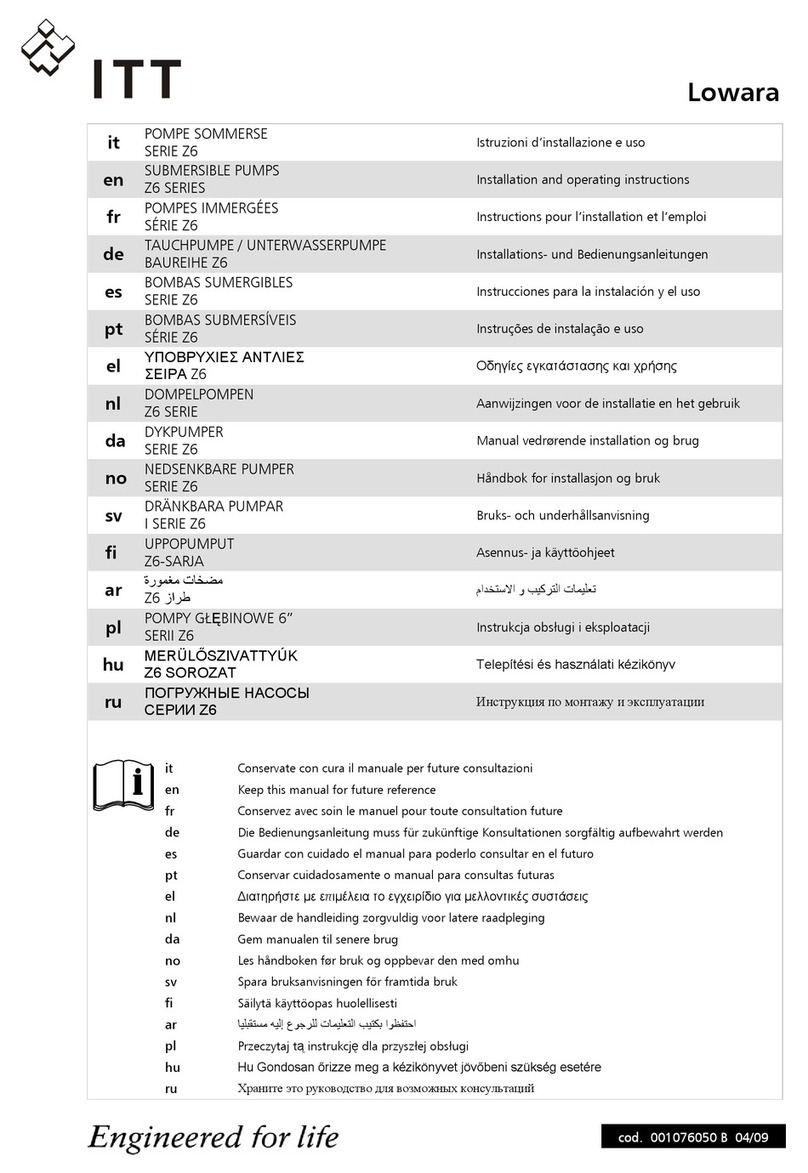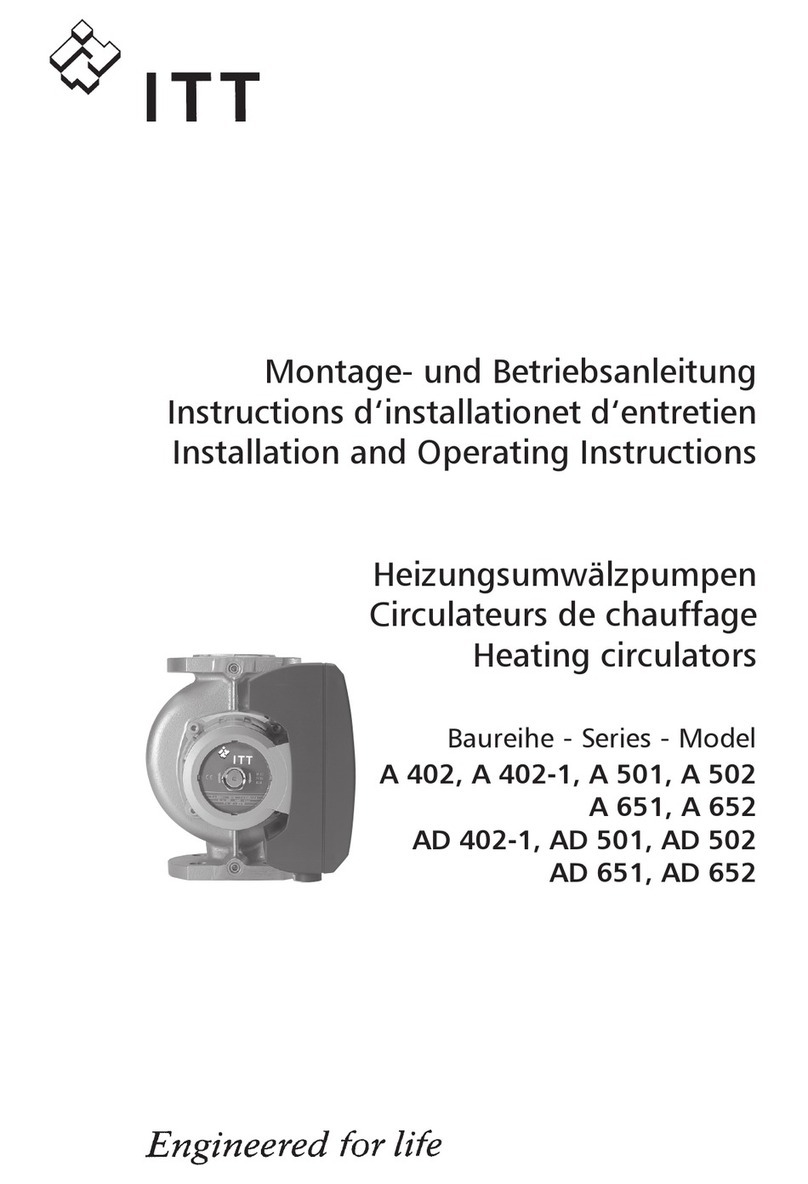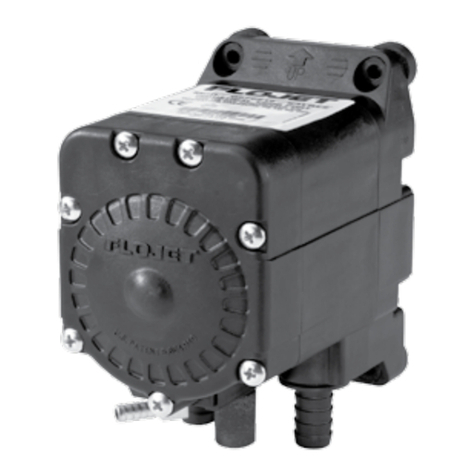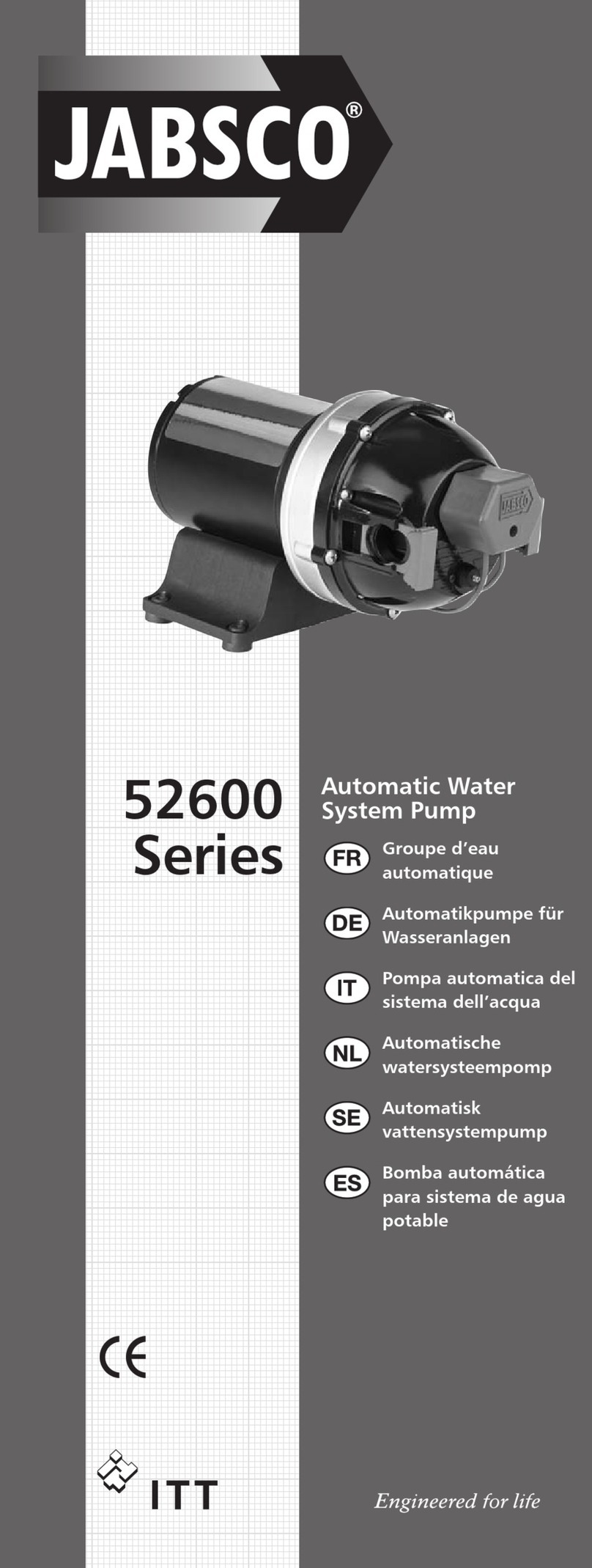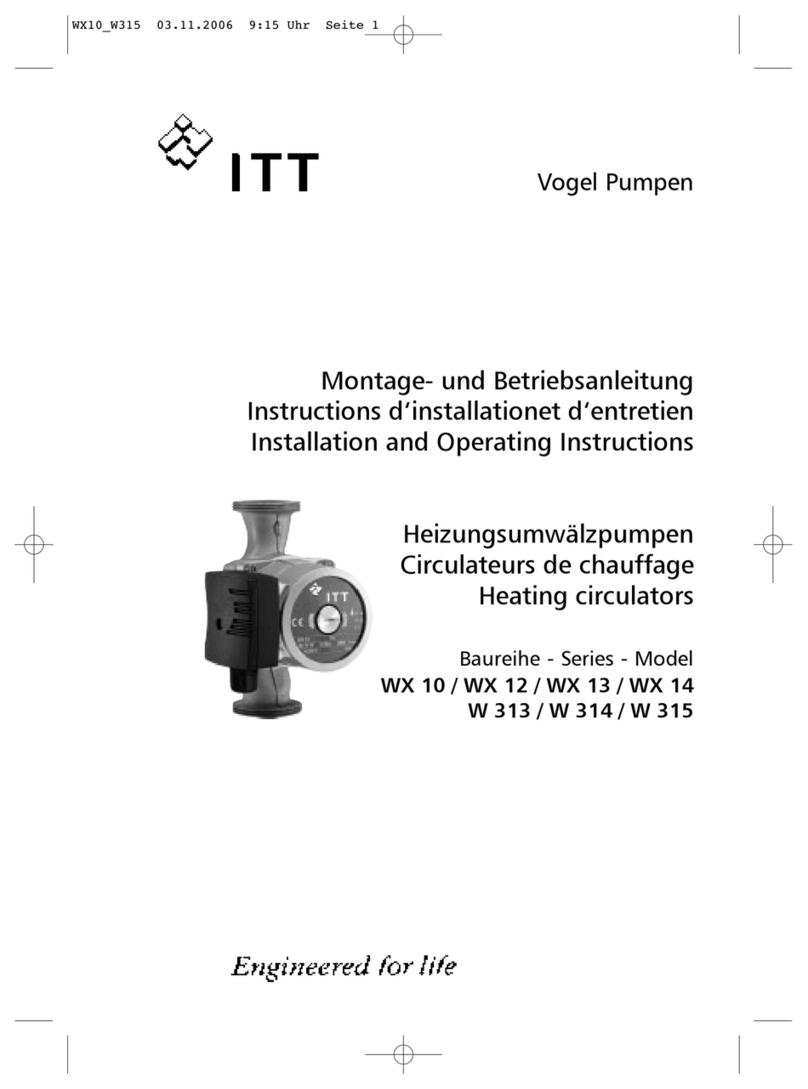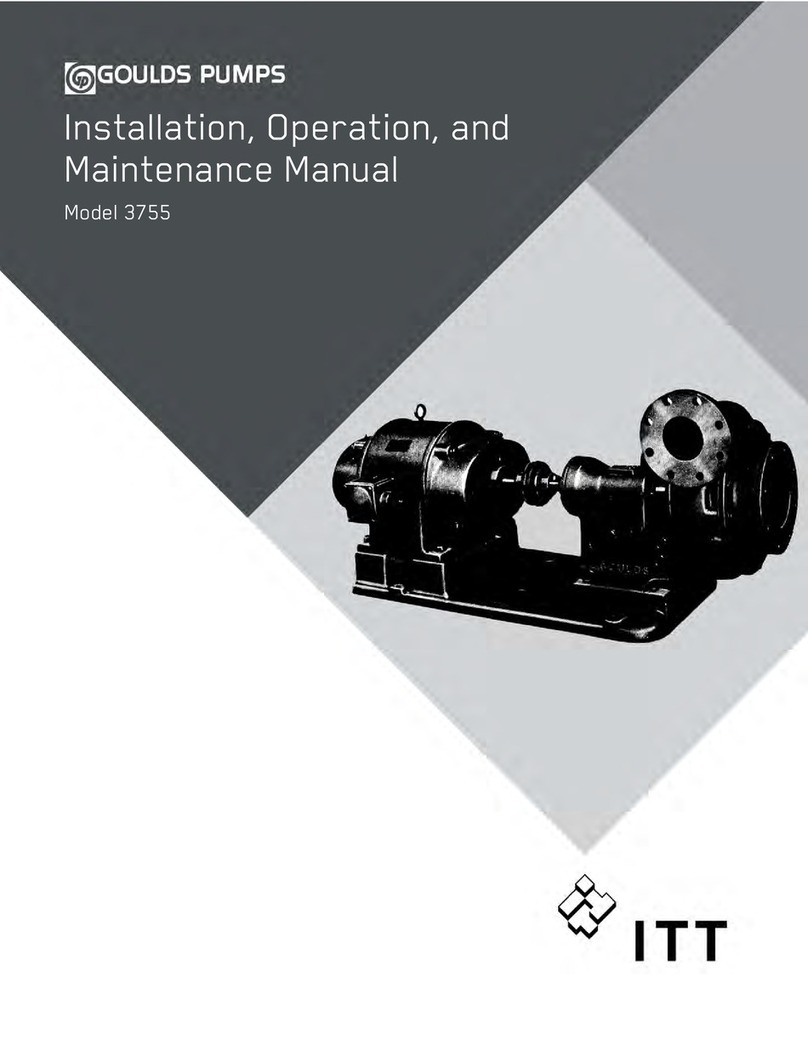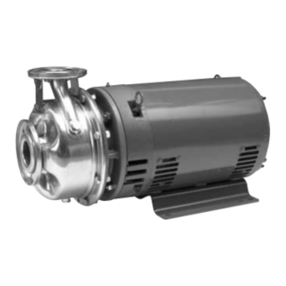
it
8
L’elettropompa non deve essere mai sollevata dal cavo del motore.
Quando ricevete l’elettropompa controllate che esternamente l’imballo non presenti danni evidenti. Se il prodotto presenta dei
danni informate il nostro rivenditore entro 8 giorni dalla consegna.
4.3 Smaltimento dell’imballo
Se non potete riutilizzare l’imballo per altri usi, procedete al suo smaltimento secondo le leggi locali vigenti sulla raccolta
differenziata dei rifiuti.
5. Installazione informazioni per l’installatore
Le operazioni d’installazione devono essere eseguite esclusivamente da personale esperto e qualificato.
Usate le idonee attrezzature e protezioni. Rispettate le norme di antinfortunistica.
Fate sempre riferimento ai regolamenti, leggi, norme locali e/o nazionali vigenti per quanto riguarda la scelta del luogo
dell’installazione e gli allacciamenti idraulico ed elettrico.
5.1.1 Posizione
Le tipologie d’installazione più frequenti sono quelle che prevedono l’uso del dispositivo di discesa per l’installazione fissa o del
piede di appoggio per l’installazione trasportabile o semi-fissa (travasi, svuotamenti scavi).
Controllate che non ci siano ostacoli che impediscono la sufficiente immersione e ventilazione per un corretto raffreddamento
del motore. Garantite uno spazio sufficiente attorno alla pompa per la sua manutenzione.
Prestate attenzione a quanto illustrato negli schemi della sezione 10.5.
5.1.1.1 Ancoraggio (per versione con dispositivo di discesa per l’installazione fissa)
Ancorate saldamente il piede di accoppiamento del dispositivo di discesa ad una fondazione in calcestruzzo mediante appositi
bulloni. Contattate il nostro Servizio di Vendita ed Assistenza se necessitate di conoscere il loro numero e dimensioni
(diametro).
5.1.2 Scelta della tubazione di mandata e valvola di ritegno
Utilizzate tubazioni adeguate alla massima pressione d’esercizio e alla portata della pompa.
Installate una valvola di non ritorno nella tubazione di collegamento con la rete fognaria pubblica / privata. In tal modo eviterete
il riflusso del liquido. Se scegliete una valvola a palla, verificate se essa sia del tipo “ a palla affondante (pesante) ” oppure “ a
palla flottante (leggera) ” poiché cambiano le condizioni di installazione ed utilizzo. Non ponete la valvola troppo vicina
all’elettropompa poiché dovete consentire al flusso del liquido, posto in movimento dalla pompa, di aprire l’otturatore della
valvola (salvo indicazioni diverse del costruttore). Valutate le perdite di carico della tubazione e dell’eventuale valvola di ritegno,
se presente. Fate sempre riferimento ai regolamenti, leggi, norme locali e/o nazionali vigenti.
5.1.3 Scelta del quadro elettrico di comando
I motori devono essere adeguatamente protetti contro il sovraccarico ed il cortocircuito.
Verificate il corretto abbinamento dei dati elettrici tra il quadro e l’elettropompa. Un abbinamento
improprio può causare inconvenienti e non garantire la protezione del motore elettrico.
Se usate relè termici consigliamo quelli sensibili alla mancanza fase.
Alcune elettropompe sono dotate, di serie o su richiesta, della sonda termica (normalmente chiusa)
posta nel motore. Questa sonda deve essere alimentata dal quadro elettrico con una tensione non
superiore a 250 Vca ed una corrente non superiore a 1,6 A. Questa sonda collegata ad un relé o al
contattore consente di fermare l’elettropompa quando il motore si riscalda eccessivamente (sonda
aperta).
Alcune elettropompe sono dotate, di serie o su richiesta, della sonda per rilevare la presenza d’acqua
nella camera dell’olio. Questa sonda deve essere alimentata dal quadro tramite un modulo elettronico
che rileva la variazione di resistenza. Sarà il modulo, collegato ad un relé o al contattore, a fermare
l’elettropompa quando sarà rilevata la presenza d’acqua nell’olio. (¼sezione 10.6).
Dovete evitare che la pompa possa funzionare senza la presenza di liquido al suo interno. Controllate
che il quadro elettrico disponga di un sistema di protezione contro la marcia a secco a cui collegare i
galleggianti.
Le elettropompe DLGM sprovviste di sonda termica vengono fornite con uno speciale quadro di protezione avente un cavo di
alimentazione con spina lungo 1 metri.
Per le altre versioni monofase assicuratevi che il quadro elettrico di comando comprenda i condensatori di marcia ed
avviamento.
5.1.4 Scelta del galleggiante/i
A seconda della tipologia di installazione, della natura del liquido e delle norme e/o consuetudini locali potete scegliere tra i
galleggianti ad azionamento elettromeccanico e quelli a contatti multipli.
Verificate il corretto abbinamento tra i galleggianti e l’eventuale quadro elettrico. Un abbinamento
improprio può causare inconvenienti.
Fate sempre riferimento ai regolamenti, leggi, norme locali e/o nazionali vigenti.
ATTENZIONE
ATTENZIONE
ATTENZIONE
ATTENZIONE
